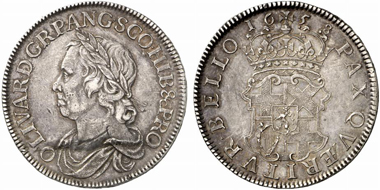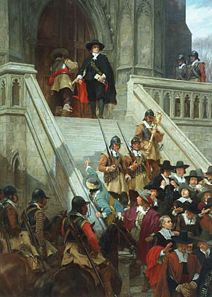by Björn Schöpe
courtesy of Barbara Balz / World Money Fair
A ghostly silence spreads when, on 30 January 1649, the severed head of King Charles I is held up to the crowd in front of his palace. Twelve years later, the body of the regicide Oliver Cromwell is excavated and his head exhibited in the same place. In the years in between, Cromwell left a trail of bloodshed across the British Isles. The attempt to build a republic had failed, and, in 1660, Charles II picked up exactly where his father had left off.
Oliver Cromwell (Lord Protector 1653-1658). Crown, London, 1658, London. Seaby 3226. From Künker auction 184 (2011), 5441.
Looking at the Cromwell silver coin, one is tempted to ask: What kind of republic was that to issue such money? On the obverse, Cromwell is represented facing, in the fashion of a Roman emperor with laurel crown and cloak of a general. The united national emblems of England, Ireland and Scotland are on the reverse – but above them, ostentatiously, is one crown. The coin bears the programmatic inscription: “Peace is sought by war”.
Under Charles I, the delicate power balance between king and Parliament had been disturbed. Both saw themselves as guardians of freedom of the English, accusing their opponents of breaking the law. In the ensuing civil war, the Parliamentarians with their modern army prevailed over the Royalists. Oliver Cromwell excelled as commander of the chivalry. Among other members of the Rump Parliament from which the Royalist members had been removed, it was him who advocated the execution of Charles, planning to lead Britain into the future as a republican Commonwealth.
Oliver Cromwell dissolving the Long Parliament, 1653. Andrew Gow, 1907. Source: Wikipedia.
First, the rebellion in Ireland had to be put down. Cromwell saw to that with his usual efficiency. The Irish remember him for massacres and mass executions. Subsequently, he also “pacified” Scotland. In the meantime, Parliament and its decisions had grown increasingly unpopular among the people, so Cromwell had it dissolved by force. After a second attempt had failed, he followed a proposition by the army in 1653. The republicans created a protectorate with set rules and representatives; nevertheless, it did not meet with the approval with its own parliament. Until 1658, Cromwell managed to act as an intermediary between army and Parliament, and keep the new construct alive. Just like a monarch, he appointed his son as his successor. However, he was unable to follow in the big footsteps of his father. Charles II returned from his exile in France and was received with open arms: England had regained its monarchy.
This article was written for the catalogue of the World Money Fair 2012 whose Guest of Honour was Great Britain. More on the World Money Fair 2012 you can read here.







